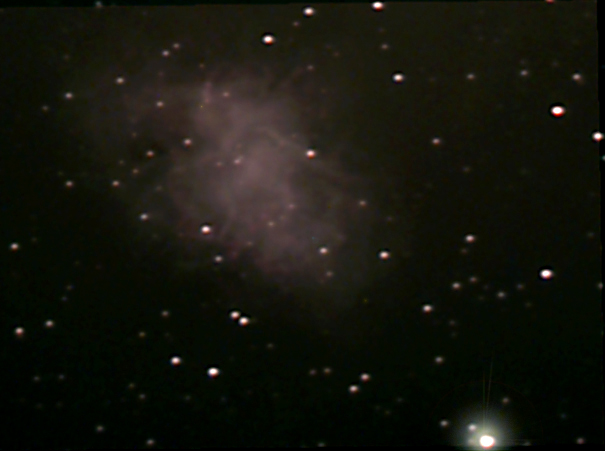
M1: Crab Nebula

RA: 5hrs 34min 30secs Dec: 22º 01' 00" Mag: 8.2 Distance: 6500 light years Constellation: Taurus
M1, the first non-cometary hazy object in the sky according to Charles Messier's catalogue of 1758 was actually the remnants of a supernova reported by Chinese astronomers, having first appeared as a naked eye object, visible even in the daytime in 1054AD. It remained visible in day light for 23 days and to the naked eye at night for 653 days! Although it continues to fade in brightness gradually, the expansion of gases is estimated at a rate of 6.5 million km/h! Undramatic to view at the eyepiece as a silvery haze, long exposure photographs reveal filamentary structure and dark dust which approximates to the breathtaking images captured by the Hubble Space Telescope as well as much larger earthbound observatories.
This photograph is the result of exposures made on 2 consecutive evenings - the 21st and 22nd of January 2006. Both nights, the temperature dropped to 0 deg C and on the second night, mist and high cloud decreased the 'seeing' quality substantially as well as adding to light-pollution by catching and diffusing light from nearby Abingdon. The exposures were made at f6.3 with no filters. The photo shown here is a stack of the best 9 pictures taken by Envisage (14 x 30, 42 x, 16 x, 13 x, 50 x, 6 x, 24 x, 42 x, and 25 x) with a cumulative exposure time of over an hour, combined in Maxim DL and saved as an auto-stretched 8-bit image, necessary for Adobe Photoshop to be able to open it. After dark adjustment, an inverted layer mask was created for the stars to prevent 'blooming' during midtone enhancement. The midtones were increased using a mixture of the levels and curves command in each individual R, G and B channels with final adjustments carried out in luminosity channel. Unsharp mask was applied, 150%, Radius = 10, Threshold = 12, after resampling to the size shown. The lens flare in the largest star was rendered.
HOME PICTURES: Deep Sky PICTURES: Solar system PICTURES: Wide field